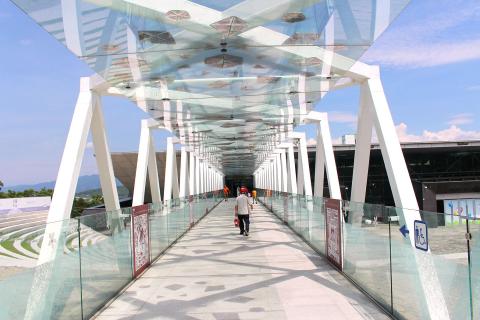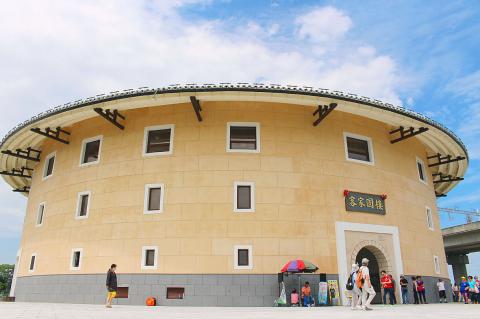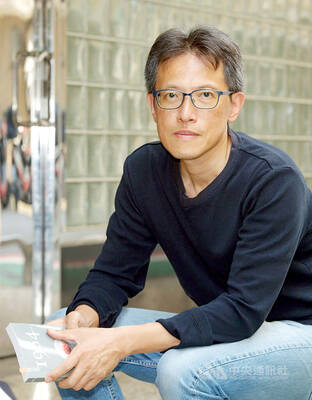Standing alone at Miaoli County’s Yingtsai Academy (英才書院), looking at a neon plastic bow and arrow behind a thick pane of glass that is supposedly an artifact of Taiwan’s Confucian education tradition, I suddenly begin to feel I’ve just wasted my NT$50.
“Before we began charging for admission, the Yingtsai Academy used to receive over 30 tour buses a day. Now, we’re lucky to have 10 on the weekend,” said a lonely security guard working double duty at the information counter, who gave his surname as Lai (賴).
Following revelations that the county’s debt had reached an untenable level and would require a bailout due to years of unbridled spending under former county commissioner Liu Cheng-hung (劉政鴻), it has begun to charge admission to recoup losses on the pricey new tourist spots.

Photo: Aaron Wytze Wilson
But a recent visit by this reporter to these Liu-era attractions was a depressing showcase of unsustainable tourism development, with most having little historical or even general interest for either local or foreign tourists. Now, they face an uncertain future as visitor numbers plunge.
MOSQUITO BUILDINGS
Miaoli County is known for its striking natural beauty, with the Houlong River (後龍溪) snaking its way through the county, and the mountains of Shei-Pa National Park (雪霸國家公園) looming large in the distance.

Photo: Aaron Wytze Wilson
In the past few years, the county has earned an unfortunate reputation for being Liu’s personal fiefdom, one where, during his nine-year tenure, he tripled the local debt to NT$64.8 billion on questionable construction projects that have sometimes spoiled the county’s natural beauty.
Liu has sought to capitalize on Miaoli’s status as a hotbed of Hakka culture, where 64.6 percent of the county claims Hakka heritage. He ordered the construction of a series of grandiose tourist attractions — the mammoth Hakka Courtyard and Culture Development Center (苗栗客家文化園區, thcc.hakka.gov.tw), the faux-historic Hakka Roundhouse (客家圓樓, hakkaroundhouse.mlc.gov.tw) and Yingtsai Academy. A museum, the Urban Planning Exhibition Center (城市規劃館, mcupec.mlc.gov.tw/), was also built as a kind of tribute to all of Liu’s public construction projects.
However, many of the above tourist spots do not seem designed with convenient transportation, quality exhibition content, or even enjoyment in mind. Reaching many of the attractions is a trying affair, with some being located at great distances from each other. Signs directing tourists to the attractions are often nowhere to be seen.

Photo: Aaron Wytze Wilson
Miaoli’s Hakka roundhouse, a modern reconstruction of a traditional tulou (土樓) earth-brick building native to China’s Fujian province, certainly appeared busy when I first visited on a Saturday morning.
Tour buses full of pensioners were paying the NT$30 entrance fee to take a look inside. But just as soon as they came in, they were out. Aside from a performance stage, a few miniature models of tulou buildings in China, there is nothing to engage a visitor longer than 20 minutes.
“It’s mostly just a place for retirees to sit in an air-conditioned building for an hour. There’s nothing else there [to do],” said Alice Wang (王美惠), a Miaoli resident who chuckled when asked what she thought of the roundhouse.
The Urban Planning Exhibition Center located in downtown Miaoli was an even sadder affair. On our weekend visit to the center, my partner and myself were the only visitors.
Upon entering the front doors, a seemingly overstaffed front desk of four receptionists were startled when we came in. They were slightly confused why we wanted to traipse around a two-storey building filled with miniature models of development projects approved by Liu.
“They call most of these new tourist attractions mosquito (蚊子館) buildings — they are totally empty, and all they’re good for is raising mosquitoes,” Wang said.
The only bright spot of these monuments to Liu is the Hakka Culture Development Center, a beautiful museum that explores the historical impact of Hakka peoples throughout China, Taiwan and Southeast Asia.
Meticulously researched, with excellent display explanations in both Chinese and English, and interactive and fun exhibits for both children and adults, the culture center is truly worth the 14km trip to the outskirts of Miaoli’s Tongluo Township (銅鑼).
LOOKING FOR A MIAO-XIT
Liu’s tourist site building extravaganza likely had an ulterior motive: land speculation. Over a span of two decades as both a legislator and a county commissioner in Miaoli, Liu benefited from a number of real estate plots he owned in Houlong Township (後龍鎮).
As building projects like the roundhouse and the new high-speed rail station sent property prices skyrocketing, Liu made millions on property sales.
But such extravagance comes at great expense to the county’s finances, the cost of building the Hakka culture center alone was a staggering NT$220 million, with construction still ongoing.
Similar building costs can be seen for the Yingtsai Academy, roundhouse and urban planning center, at NT$91 million, NT$130 million and NT$164 million respectively.
With dwindling tourist numbers, and mounting construction debts and IOUs, Miaoli’s new county commissioner, Hsu Yao-chang (徐耀昌), has began to charge admission and parking.
Needless to say, many residents are less than sanguine about the changes.
“I’ve already gone once when it’s free. I don’t know if I’d go again now that there’s an entrance fee,” said Lin Chi-yan (林季妍 ), when asked about the Hakka Roundhouse.
“I didn’t think anyone outside of Miaoli even knew these places existed. There’s nothing fun about those places,” said Miaoli resident Hsu Chia-chen (許家禎).
Attractions that have not enacted admission and parking fees are now in a catch-22 situation. If they charge a fee, no one will come. If they don’t charge, they slide further into debt. But with annual operation costs of NT$42 million for the combined Liu-era tourist spots, the financial pain is sure to continue. County commissioner Hsu may be seeing more mosquito buildings in the near future, thanks to his predecessor.

Three big changes have transformed the landscape of Taiwan’s local patronage factions: Increasing Democratic Progressive Party (DPP) involvement, rising new factions and the Chinese Nationalist Party’s (KMT) significantly weakened control. GREEN FACTIONS It is said that “south of the Zhuoshui River (濁水溪), there is no blue-green divide,” meaning that from Yunlin County south there is no difference between KMT and DPP politicians. This is not always true, but there is more than a grain of truth to it. Traditionally, DPP factions are viewed as national entities, with their primary function to secure plum positions in the party and government. This is not unusual

Mongolian influencer Anudari Daarya looks effortlessly glamorous and carefree in her social media posts — but the classically trained pianist’s road to acceptance as a transgender artist has been anything but easy. She is one of a growing number of Mongolian LGBTQ youth challenging stereotypes and fighting for acceptance through media representation in the socially conservative country. LGBTQ Mongolians often hide their identities from their employers and colleagues for fear of discrimination, with a survey by the non-profit LGBT Centre Mongolia showing that only 20 percent of people felt comfortable coming out at work. Daarya, 25, said she has faced discrimination since she

April 21 to April 27 Hsieh Er’s (謝娥) political fortunes were rising fast after she got out of jail and joined the Chinese Nationalist Party (KMT) in December 1945. Not only did she hold key positions in various committees, she was elected the only woman on the Taipei City Council and headed to Nanjing in 1946 as the sole Taiwanese female representative to the National Constituent Assembly. With the support of first lady Soong May-ling (宋美齡), she started the Taipei Women’s Association and Taiwan Provincial Women’s Association, where she

More than 75 years after the publication of Nineteen Eighty-Four, the Orwellian phrase “Big Brother is watching you” has become so familiar to most of the Taiwanese public that even those who haven’t read the novel recognize it. That phrase has now been given a new look by amateur translator Tsiu Ing-sing (周盈成), who recently completed the first full Taiwanese translation of George Orwell’s dystopian classic. Tsiu — who completed the nearly 160,000-word project in his spare time over four years — said his goal was to “prove it possible” that foreign literature could be rendered in Taiwanese. The translation is part of